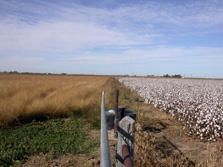GRIFFIN, Georgia – The Southern Sustainable Agriculture Research & Education (SSARE) program will be releasing a special Grant Call in 2020 seeking Systems Research Project proposals for sustainable agriculture research that focus on a Systems Research approach. Project maximum is $1 million for activities funded for three years.
Most agricultural field research is component research – analyzing a part of a system in isolation to the other system’s components to seek a solution to one problem. While good information has been gained from well-conducted component research, one of the shortcomings of a component view is that sometimes a solution to a problem creates new problems to be solved. In addition, component research provides results that often only offer short-term solutions to long-term problems.
As researchers dig deeper into the impacts of component research on other parts of the system – either because the research drives it or society demands it – the research agenda is becoming more complex. With this complexity in mind, we are finding that systems research is becoming more important to addressing the questions and finding the methods needed for a more balanced, long-term sustainable agricultural system. Systems research provides the opportunity to probe the interrelationships of all parts of a system in a long-term environment to answer questions related to profitability, environmental stewardship and community quality of life as the system changes over a long period of time.
Applicants interested in applying for the SSARE $1 million Systems Research Grant must submit a Letter of Intent to assess if their project idea matches the objectives of the grant.
Letters of Intent should be e-mailed to Jeff Jordan at jjordan@uga.edu by May 1, 2020. Late submissions of Letters of Intent will not be accepted.
The Project Review Committee of the Administrative Council will review the submitted Letters of Intent after the May 1 deadline, and invite potential applicants with acceptable proposal ideas to submit a full grant proposal. The proposal will be provided via e-mail. Those invited to submit a full proposal should expect to receive the application in August. The due date of the full application is Nov. 13, 2020 with proposals awarded February 2021. The projected start date of the project is April 1, 2021.
Provide up to a two-page summary of your proposed project and include the following information:
- PI name, institution address, phone number and e-mail address;
- Co-PIs (if any) and other institutions involved;
- Abstract of your research proposal and how it incorporates SARE’s Three Pillars of Sustainability: farmer profitability, environmental stewardship, community quality of life. Begin your abstract with “The purpose of this project is to….”;
- A concise list of objectives and research methods;
- A summary of your budget request;
- How the project proposal focuses on systems research, and why this funding is required to address the continuity of your systems research efforts;
- An explanation of what other funding, if any, has been awarded related to your proposed project.
For any questions, contact Candace Pollock-Moore at cpollock@uga.edu.
Published by the Southern Region of the Sustainable Agriculture Research and Education (SARE) program. Funded by the USDA National Institute of Food and Agriculture (NIFA), Southern SARE operates under cooperative agreements with the University of Georgia, Fort Valley State University, and the Kerr Center for Sustainable Agriculture to offer competitive grants to advance sustainable agriculture in America's Southern region. This material is based upon work that is supported by the National Institute of Food and Agriculture, U.S. Department of Agriculture, through Southern Sustainable Agriculture Research and Education. USDA is an equal opportunity employer and service provider. Any opinions, findings, conclusions, or recommendations expressed in this publication are those of the author(s) and do not necessarily reflect the view of the U.S. Department of Agriculture.
